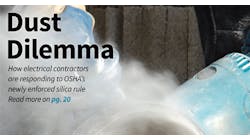Voltage sags can be just as detrimental to your plant as a complete outage
Because a large portion of power supply systems experiences a voltage sag whenever a fault occurs, voltage sags are much more common than actual interruptions. This makes it even more important for you to understand the sensitivity of your equipment to voltage sags and the options available for protecting your equipment and systems.
Voltage sags occur whenever a short circuit occurs on either the utility transmission or distribution system that supplies your facility. If you happen to be downstream of the protective devices on these systems that operate to clear the fault and are therefore located on the faulted section, you will experience an interruption. Usually, it will only be momentary because most faults are “temporary,” and a protective device like an automatic recloser, can reenergize the circuit very quickly.
Even if you're not on the faulted circuit, this event can still affect you because the fault can cause a voltage drop over a large portion of the supply system until it's cleared by the breaker or recloser. Many types of industrial processes can be just as sensitive to this event as they are to an actual power interruption. With the interconnected nature of many industrial processes, even if a voltage sag affects just one piece of equipment, it may affect a whole manufacturing process.
Equipment sensitivity.
The main factor that determines whether voltage sags will affect your facility is the sensitivity of the equipment in your process. The sensitivity curve developed by the Information Technology Institute Council (ITIC) shows that computer equipment should be able to ride through short duration voltage sags if the voltage doesn't go below 70% (Fig. 1 above). For longer duration sags, voltages below 80% could affect the equipment. See “Ask the Experts” on page 52 for a more in-depth discussion of the ITIC curve.
One problem is that many people often don't know the true sensitivity of their equipment. EPRI-PEAC has tested numerous types of industrial drives, equipment, and controls and maintains a database of equipment sensitivity. However, new equipment is continually introduced, and the group often has to go into industrial facilities to test the sensitivity of equipment and processes with a voltage sag generator. This process identifies the sensitive piece of equipment and helps determine the best solution.
How many voltage sags do you expect?
The number of voltage sags that can occur at your facility depends on where you're located, the characteristics of the utility's distribution system, such as underground vs. overhead, lengths of the distribution feeder circuits, and number of feeders, the lightning level in the area, the number of trees adjacent to the power lines, and several other factors.
From 1993 to 1995, EPRI conducted a major benchmarking project for utility distribution systems across the United States. Based on the results of this project, distribution utility customers can expect an average of about 18 events per year in which the minimum voltage goes below 70% (referred to as SARFI-70). This is much higher than the average number of outages a customer can expect, which is about 1.3.
Many utilities have used monitoring projects to provide their customers with better information about how many voltage sags to expect. Facility engineers need this information to evaluate the economics of different alternatives for improving the facility performance during these voltage sag events. When characterizing the expected performance, you should separate the voltage sags caused by transmission system faults from those caused by distribution system faults (Fig. 2). This will help you understand where your investments can help improve performance, and it may also indicate possible solutions on the utility side of the meter.
Protecting individual equipment.
Usually, not all the equipment in your facility requires support during voltage sags. In fact, many types of equipment can ride through these short duration events without a problem. Adjustable speed drive manufacturers offer options for riding through voltage sags. Most motor loads can ride through voltage sags without affecting the process due to the inertia of the motor and the load — unless the motors drop out because of the sensitivity of contactors or relays protecting the motor.
There are many options for protecting individual loads or groups of equipment within a facility. Of course, you can use the traditional UPS systems, but this may not be the best solution. If most of the events affecting the process are voltage sags, not interruptions, there are probably many more economical alternatives. Even if you need protection for short duration interruptions, new options with flywheels, superconducting magnets, or capacitors for energy storage might be preferable because they're much smaller and don't require battery maintenance. You have a few other options to consider, including the following:
- Distribution voltage restorer (DVR) for low-voltage systems
A number of manufacturers offer the DVR technology in sizes for protecting individual loads and groups of loads. This is often the best solution when voltage sags are the dominant concern.
- Standby UPS with flywheel energy storage
These units provide ride-through performance during short-duration interruptions and voltage sags. They avoid the maintenance headaches of batteries while still providing protection for the majority of interruptions. Most faults are temporary, and interruptions last less than a few seconds.
- Other options
For adjustable speed drives, you may be able to purchase an option for ride-through from the manufacturer. If not, one manufacturer offers a device to support the voltage in the DC link of the drive during voltage sag conditions. This allows the inverter to continue operating and supplying voltage to the motor until the input voltage returns to normal. Another product uses magnetics to provide voltage regulation and voltage sag ride-through support in sizes as high as 200kVA.
Protecting your entire facility. One option for improving the reliability of your power supply is to add protection for the entire facility. Some utilities offer this protection for an additional charge by connecting a device called a distribution voltage restorer (DVR) at the supply to a facility. When a voltage sag occurs, the DVR boosts the voltage to maintain a constant level to all the loads being protected (Fig. 3 at right). This will provide protection for a great majority of events that may affect your industrial processes. Essentially, only complete power interruptions will still affect your plant.
Protecting controls.
Before you spend a lot of money on power conditioning equipment to protect your entire process, make sure the process controls aren't causing the whole process to shut down during voltage sags. Programmable logic controllers (PLCs), relays, and contactors are often the most sensitive equipment in the process. They're also the easiest to protect. For example, constant voltage transformers (CVTs), also known as a ferroresonant transformers, can provide voltage support for most voltage sags, especially if they aren't operated at full load.
A smaller and lighter option for protecting control circuits is a single-phase version of the DVR technology discussed previously. Of course, you can also use a small UPS for this purpose too.
A voltage sag is only as strong as your most sensitive equipment is weak. Knowing the sensitivity of your facility's equipment is the most important part of preparing for interruptions and an integral part of choosing the right protective device.
Sidebar: Improving Equipment Ride-through Characteristics
Ultimately, better equipment design is the best long-term solution for voltage sag problems. If manufacturers offered options for improved ride-through, it might be more economical to purchase these options than to install external devices for protection.
The semiconductor industry, in cooperation with EPRI and electric utilities, recognized this and developed a set of standards to provide better compatibility between the equipment characteristics and the characteristics of the utility supply. One specifies an improved voltage sag ride-through for process tools. It requires a ride-through down to 50% voltage for 200 msec, which will significantly reduce the number of voltage sags that may cause process disruptions in semiconductor plants. Many other industries can use this as a model to improve compatibility. In fact, EPRI-PEAC is currently working with utilities and the automotive manufacturers on an initiative started by the Tennessee Valley Authority that may result in similar guidelines for the automotive industry.
Sidebar: Evaluating the Economics
Deciding on the best alternative for improving voltage sag ride-through performance at your facility is a problem that comes down to simple economics. You first have to understand the sensitivity of the equipment and how much it costs every time the equipment is affected. Then you need information from the electric utility that estimates how many voltage sags you can expect to see on your system per year. With this information in hand you can then determine your costs associated with voltage sags. The optimum solution will minimize the combined costs of the ride-through solution and the resulting losses from the events not solved by the specific solution — the cost of the solution plus the cost of the disturbances.
The solution costs are lower as you focus on the particular equipment and controls that are sensitive. However, this approach may have additional costs associated with characterizing the sensitivity of the process components and installation. Efforts to understand the sensitivity of all parts of your process are usually very worthwhile in coming up with the best solution.



